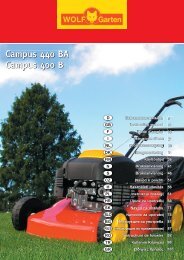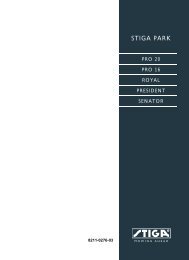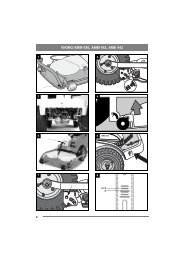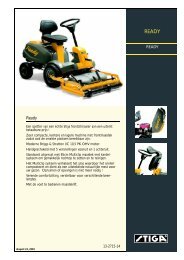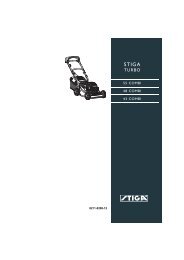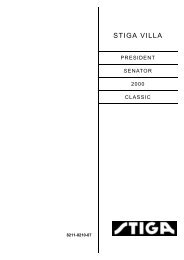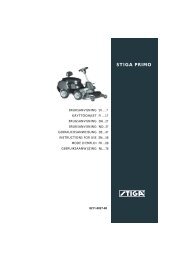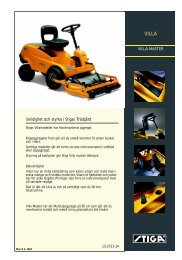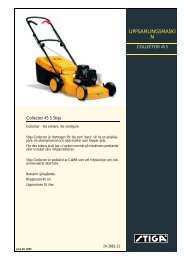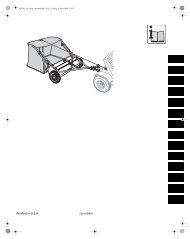You also want an ePaper? Increase the reach of your titles
YUMPU automatically turns print PDFs into web optimized ePapers that Google loves.
76<br />
GB<br />
2.2 Combination with cutting deck<br />
Accessories<br />
Titan<br />
20 B 26 B 26 H 26 HS<br />
Cutting deck 125 B X X<br />
Cutting deck 135 B X X<br />
Cutting deck 155 B X<br />
Cutting deck 135 H X X<br />
Cutting deck 155 H X X<br />
For other accessories, contact an authorised dealer<br />
and read the following instructions for use.<br />
3 DESCRIPTION<br />
3.1 Drive<br />
The machine is four wheel drive. The power from<br />
the engine to the driven wheels is transferred hydraulically.<br />
The four wheels are equipped with<br />
separate hydraulic motors. The diesel motor drives<br />
a hydraulic pump (3:P), which pumps oil through<br />
the hydraulic motors (3:M) of the wheels.<br />
The hydraulic motors are connected to the hydraulic<br />
pump according to fig. 3.<br />
This means that the front and rear wheels are<br />
forced to rotate at the same speed, but the speed on<br />
the right and left side can vary.<br />
Front mounted implement driven by drive belts or<br />
hydraulically, depending on model.<br />
3.2 Steering<br />
Keep all body parts away from the<br />
machine’s pivot point when the steering<br />
wheel is turned. There is a risk of<br />
serious crushing injury between the<br />
machine’s rear and front sections.<br />
The machine has articulated steering, which is<br />
power assisted. This means that the chassis is divided<br />
into a front and rear section, which can be<br />
turned in relation to each other.<br />
The articulated steering means that the machine<br />
has an extremely small turning circle and can be<br />
easily tuned around trees and other obstacles.<br />
3.3 Safety system<br />
The machine is equipped with an electric safety<br />
system. The safety system stops certain activities<br />
that may be hazardous in the event of incorrect operation.<br />
E.g. The engine cannot be started if the<br />
clutch pedal/parking brake is not depressed.<br />
The safety system’s function must<br />
always be checked before use.<br />
ENGLISH<br />
3.4 Controls<br />
3.4.1 Implement lifter (1:F1)<br />
The hydraulic implement lifter only works when<br />
the engine is running.<br />
However, it can be lowered to the floating position<br />
when the engine is off.<br />
Never leave the machine with the implement<br />
in the transport position. Risk of<br />
serious crushing injuries by the implement<br />
as it lowers quickly if the control<br />
is unintentionally affected.<br />
The lever has the four following positions:<br />
Floating position. Move the lever to its<br />
front position, where it locks. The implement<br />
is now lowered to its floating position.<br />
Also see “3.4.2”.<br />
In the floating position, the implement<br />
always rests against the ground at the<br />
same pressure and can follow the contours<br />
of the ground.<br />
Use the floating position when carrying<br />
out work.<br />
Lowering. The implement lowers regardless<br />
of its weight. The lowering<br />
speed can be set using the control (4:X).<br />
The lowering force is determined by the<br />
implement’s weight and the hydraulic<br />
down force that is applied when lowering.<br />
Locking in the transport position. The<br />
lever has returned to the neutral position<br />
after raising and lowering. The implement<br />
is locked in the transport position.<br />
Raising. Move the lever to the rear position<br />
until the implement is in the highest<br />
position (transport position). Then release<br />
the lever to lock in the transport position.<br />
3.4.2 Check valve lowering (4:X)<br />
The check valve regulates the speed when lowering.<br />
The speed must be adjusted according to the<br />
weight of the actual implement.<br />
Increasing the lowering speed:<br />
Undo the nut (4:Y) and turn the knob to the left.<br />
Reducing the lowering speed:<br />
Undo the nut (4:Y) and turn the knob to the right.<br />
The check valve must be locked in the set position<br />
with the nut.<br />
3.4.3 Hydraulic control (1:L1)<br />
This control is used to control certain functions depending<br />
on the attached implement.<br />
The control only works when the engine is running<br />
and the implement’s hydraulic hoses for the intended<br />
function are connected to the hydraulic output<br />
(1:L).



